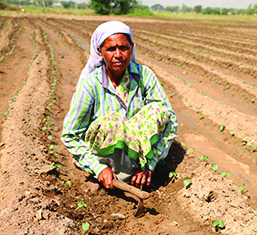Ajay Kumar is a bright young man from Purnea district of Bihar, India. In his early 20’s, Ajay is in the final year of his graduation and lives with his parents and younger sister and an older brother who is married and has one child. Their family of seven depends on vegetable farming and Ajay helps his father and brother in the field when possible.
Ajay became a mediator or (VRP) in 2013, after receiving a training from Digital Green on disseminating how-to

videos about best practices related to agriculture. Digital Green’s SRI videos were crucial to establishing SRI practices among farmers. “It was the first time that 20 farmers opted for SRI after watching a video”, shares Ajay, whose family too adopted practices like seed treatment and line sowing after watching the Digital Green videos, which helped them reduce their costs for cultivation.
This is a testimony to Digital Greens hugely successful partnership with Bihar Rural Livelihood Promotion Society (BRLPS), locally known as JEEViKA which started in 2012 initially covered 100 Villages of two blocks of Muzaffarpur district. In the year 2015, this partnership grew stronger with the project being extended for yet another year, expanding its outreach to all 38 districts of the state. Scaling the project to so many districts also meant great responsibility. The responsibility of not just growing in quantitative measures but maintaining desired quality standards also. It was thus envisaged that efforts would be made alongside to institutionalize Digital Greens processes at grassroots. To make the approach and quality processes more grounded, stable and sustainable, the role of Master Resource Persons (MRP) became crucial.
Both Digital Green and JEEViKA got down to the task of building a band of MRPs across the region that could handle the role of supportive supervision to mediators and remain exclusive to Digital Greens intervention. JEEViKA developed a position of an MRP which is equivalent to the Skilled Extension Worker (SEW) within their organizational structure.
An MRP is tasked with looking after 20 mediators spread across 20 distinct villages in a block. An MRP monitors and supports the video mediators assigned to them, ensures they have forms to data capture, consolidates and validates data captured in these forms, distributes videos, conducts review meetings, observes dissemination process and provides feedback on quality based parameters to a mediator for further improvement. S/he also makes field visits doing sample adoption verification to validate the behavioural changes claimed and reported by mediators.
Earlier, these MRPs worked as mediators after going through Digital Greens dissemination training program. Video mediators performing exceptionally were selected meticulously and trained on aspects of quality assurance such as dissemination observation, adoption verification, and forms verification. Some of these MRPs have also gone through Training of Trainers (ToT) program and support the staff of Digital Green and JEEViKA during dissemination training in their respective districts.
Ajay has also attended one such ToT and became an MRP last year and now puts all his efforts into training and supporting mediators in Purnea district of Bihar. Many training participants take a while to recognize him as a trainer due to his boyish appearance, given that many of them are perhaps twice as old as Ajay. Ajay does not let this bother him. “Their doubts vanish as soon as I start the training sessions, facilitating them on different topics of dissemination training”, says Ajay, thus establishing himself as a Master Resource Person. Ajay also conducts review meetings with mediators at the block level where he collects forms documented by mediators and validates the documentation. He also visits different villages to observe dissemination and verify adoptions and has become well known among Village Resource Persons (VRPs) of Barharakothi block of Purnea district.
In 2015, Digital Green’s Bihar team focused on emphasizing the role of MRPs to maintain and sustain its efforts at grassroots. The team believed that devoting more time and resources on an MRPs inclusion in training programs, dissemination observation, review meetings, and adoption verification would be conducive to ensure quality. This would also support in shifting the ownership of the process of ‘behavior change’ towards those who belong to the community. Thus, our team decided to proceed with training these MRPs, refreshing their concepts on different aspects to maintain quality and sustain the program. A new training module was also developed to serve the purpose. Around 116 MRPs were trained to support field operations and maintain quality. These MRPs have observed more than 700 disseminations in 2015 that has helped us to maintain qualitative measures. The data reported from these observations serve as a source for analysis and further improvement.
Ensuring quality at every stage of the various processes has been vital to Digital Green’s strategic objectives. Maintaining quality in training, video production and dissemination has eased our pursuit to achieve scale with quality. And now we have a strong band of MRPs supporting us in this endeavor, helping us keep our work further grounded in the community.








